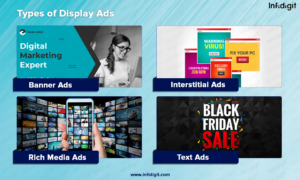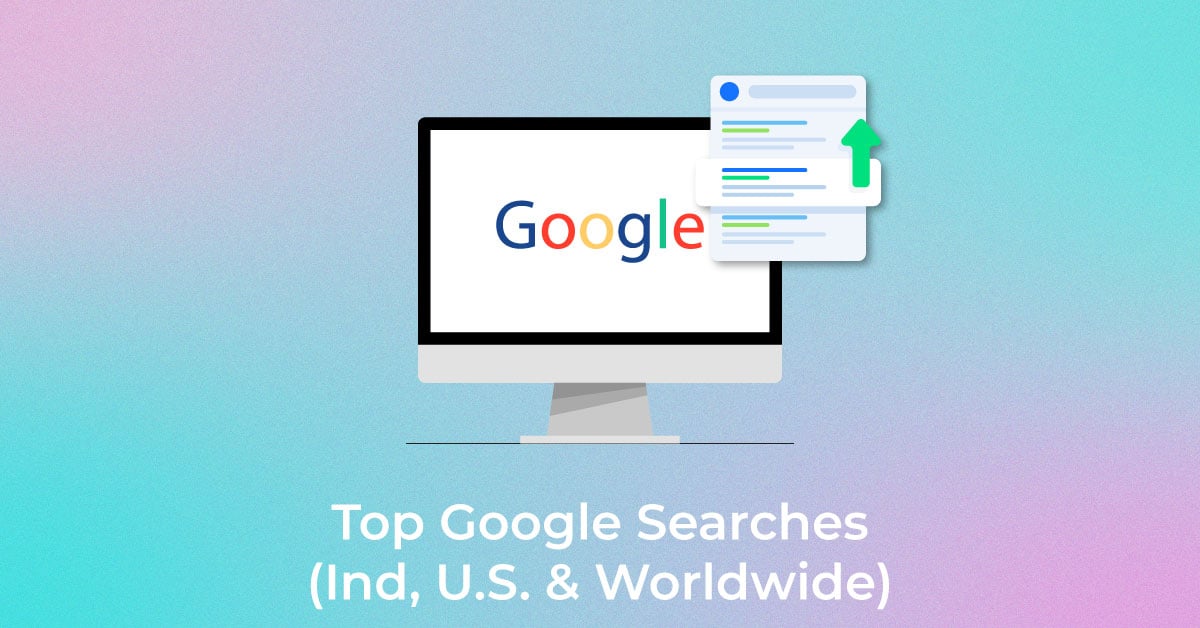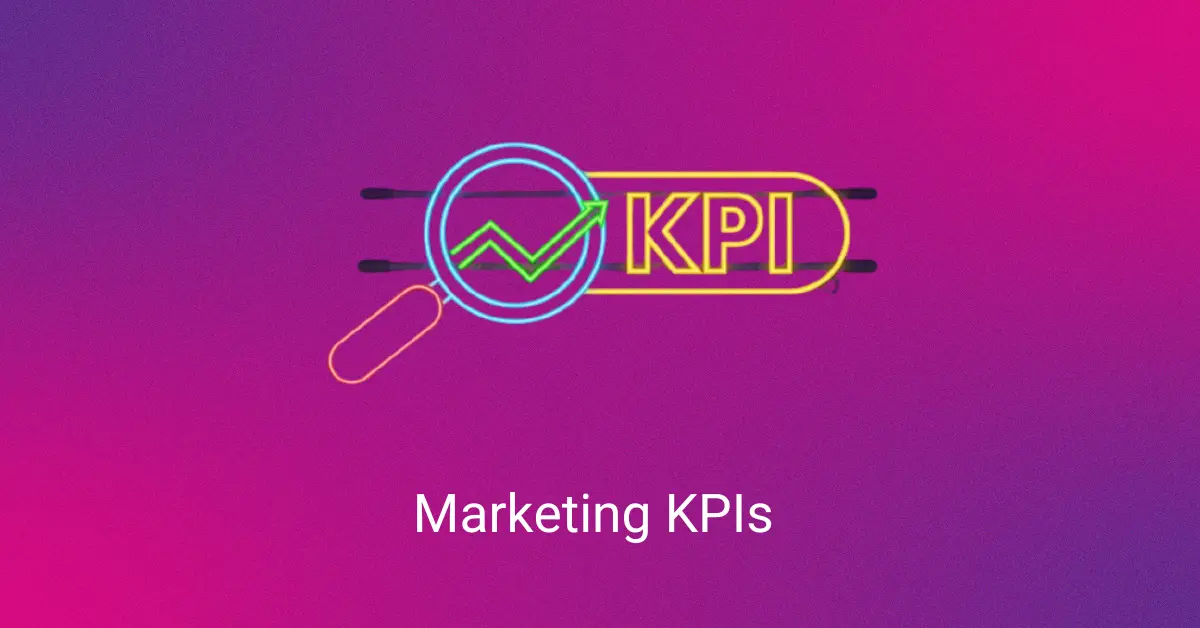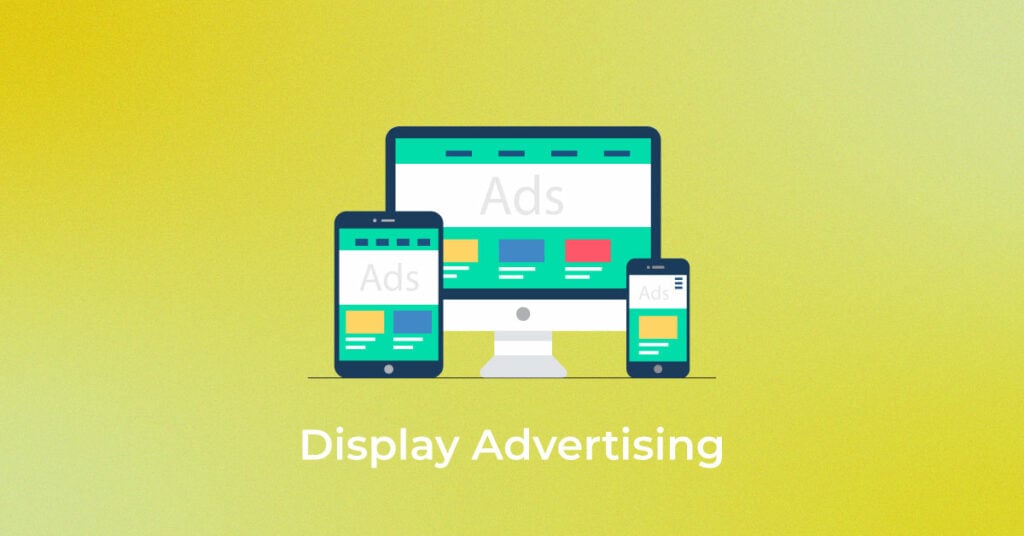Display ads are a form of online advertisements that feature a blend of URL, text, and images presentable in multiple formats. There are various types of display ads, like static or animated images, videos, or rich media ads.
The purpose of a display ad can be to educate the audience or to entertain them or, even better, to engage them with some game or puzzle. Display ads help promote the brand when people browse online, check their emails, watch YouTube videos or access mobile apps.
Considering the perks of display ads, many brands are employing them to lure internet users. US companies are expected to invest 79.75 billion dollars in display advertising by 2021, making display advertising one of the fastest-growing digital advertising categories.
What is Display Advertising?
Display advertising is the graphical form of advertising on the internet through the use of text, flash, video, images, and audio. It may appear on the website, on apps, on the social media page, or any other third-party URL. There is no constraint regarding the size, text, shape, or size of the display ads. Display ads are run through multiple display ad networks like Google ads or Facebook advertising for a filtered target approach.
The pricing of display ads is based on the PPC model. Wondering what is PPC? In a price per click (PPC) model, the brand is required to pay the price of the ad only when someone clicks on it.
Importance of Display Advertising
Display advertising is a very effective and popular format of digital advertising. This go-to method is used by marketers to reach a much broader and specific set of audiences. Because of its visual display, it is considered to be the most appropriate means of advertising in the digital ad world. However, there are many more perks attached to display advertising, such as:
- Display ads have an outstanding reach. The Google ad network alone has a reach of 90% across the internet.
- It is beneficial for raising brand awareness since it’s cost-effective and specifically targeted.
- The visual display grabs the audience’s attention easily and has a longer retention span.
- It has multiple targeting options like contextual, placement, demographic and behavioural.
- One of its major advantages is its low-cost flexible payment options, like cost per click (CPC) and cost per impression (CPM).
- The response to digital ads can easily be tracked in terms of the number of clicks on them or the impression created by them.
Types of Display Ads

-
Banner Ads
Banner ads are the most traditional and popular form of display ads. These ads have multiple formats and sizes across websites and can be used across multiple display ad networks, like Google display network (GDN) and Microsoft audience network (MSAN). Demand-side platforms (DSPs), social channels like Facebook, niche platforms like Terminus, and 6Sense for account-based marketing (ABM) also work great for banner ads.
Banner ads have a display similar to digital billboards. They find their place in high traffic zones like the bottom, front, or side of the webpage and can have multimedia content or an image or HTML content. Such ads are much preferred because of their undisturbed unidirectional approach.
-
Interstitial Ads
Interstitial ads are full-screen images or HTML ads that cover the interface of their host site or app. They’re typically displayed in the middle of content flow, such as between the levels in a game or the middle of activities. On these ads, viewers have the option to continue with the ad or simply close the ad and proceed with the content. Their 100% screen coverage differentiates them from pop-up ads or banner ads.
-
Rich Media Ads
Rich media ads, also referred to as interactive ads, include videos, GIFs, audio, and more. These ads engage the audience in video games or polls and surveys. One can make use of these ads to provide product information and increase customer engagement. They are creative and visually impressive ad forms.
-
Text Ads
Text ads are used across Google Ad Network to promote the products or services of any brand. They appear on Google result pages, search networks, and display networks. These ads are often labeled as advertisements for clear communication that they are paid forms of promotions.
What are Display Networks?
Display network in digital marketing refers to the group of over 2 million websites, apps, and videos where display ads are visible. With a display network, one can target a specific set of audiences with specific content at a specific location. Google display network or GDN is the most popular and well-programmed display network, with Facebook and Apple being other popular options.
The major advantage of a display network is that it gives the user the liberty to choose when, where, and whom to display the ad. Display network advertising increases the chance of converting the prospects into customers. Its effective targeting method ensures that the ads get clicked by the right person at the right time.
How can Display Networks help with Effective Targeting?
The much-filtered approach towards choosing the target audience for a particular ad makes display advertising a great digital advertising medium. Display network advertising makes use of demographics and consumer interest as parameters to segment the audience.
For demographic targeting, the factors considered are:
- Age
- Gender
- Relationship status
- Household income
- Race
Based on interests, the audience is categorized as:
- Affinity audience – Categorization is based on interests and hobbies, for instance, car lovers.
- Custom affinity audience – Custom audience created using keywords and URLs. The audience is further narrowed down based on their hobbies. Example: Sedan car lovers.
- In-market audience – People who are already in search of your product or service. Example: X brand sedan car lovers.
Often, marketers make use of both kinds of factors – demographic and interest-based to conclude a segment of the audience. All this ensures that the right ad is being clicked by the right audience at the right time and place, improving the probability of ad conversion.
Benefits of Display Advertising
-
Boosts brand awareness and reach
Display advertising allows the brand to let the audience know about their product and services much before their actual need arises. Also, the geofencing technique allows the marketers to direct the ads on mobiles, based on the current location of customers.
-
Convey your brand message quickly
Because of their visual display and sometimes interactive format, display ads can communicate their core message with much speed and efficiency. These are ads customized to meet the need and understanding of the target audience.
-
Easy to create
If you understand the basic structure of the display ad and are aware of the principles that govern the designing of an effective display ad, you can lure the audience easily. Google recommends the 3Cs (compelling, clear, and concise) for creating a successful display ad. Also, there are multiple software options available in the market that have further lowered the efforts but improved the outcome of display ad designing.
-
Reach your target audience at every stage of the sales process
Display ads are useful in building and maintaining brand awareness in every stage of the sales process. They help to connect with the right audience at the stage of need awareness and purchase readiness. They ensure brand awareness on the parameters of adaptive keywords, detailed demographics, and affinity.
-
Cost-Effective
Display ads are value for money since they reach a broader segment of the audience while involving less operation cost. Designed based on CPC (cost per click model), you need to pay for these ads only when someone clicks on them. This means your every penny spent on the ad is measurable. It is much cost-effective compared to other traditional advertising mediums too.
Drawbacks of Display Advertising
-
Contradictory behaviour towards ads
Unlike traditional means of advertising, display ads are considered more intrusive and annoying. People are offended by sudden pop-ups of ads or display of visual ads when they are busy browsing some content of their interest online. As a result, people opt for software that can help them block unnecessary display ads.
-
Short length
Display ads are too direct and simple. And sometimes, this short length of these ads goes against them. Therefore, although display ads are a good magnetic tool to attract the attention of prospects, they are not an ideal way of educating them about the product or service. Brands that deal in financial products need long-form content to outshine their competitors and compel the buyers to use them.
-
Relatively low click-through rate
Display ad formats like banner ads have a much less click-through rate as compared to other mediums of digital advertising. This is because the display ads generate brand awareness and not drive in or increase traffic. The average click-through rate of display ads is approximately 1% whereas Google demands a minimum of 2% CTR to tag the ad as above average.
Display Ads Best Practices
-
User Experience
To provide a happy and healthy user experience, avoid any kind of auto-play video formats or pop-up ads. In this way, your ad will only be viewed by those genuinely interested in them. Also, ensure that the ad does not cover 1/3rd of the screen.
-
Use a simple but appealing design
Make use of simple and clear design, which can convey your message. Considering the limitation in size and design of display ads, one should avoid any clumsy look, as that might distract the viewer from the actual purpose of the ad. Have a concise and clear ad copy.
-
Work on the quality of your ad copy
Keep the ad copy short and simple. Use words that are easy to comprehend by the target viewer. Also, keep in mind the purpose for which the ad is planned. All these simple points lead to the effectiveness of an overall ad copy.
-
Add a powerful CTA
CTA refers to a call to action. An effective CTA encourages the user to visit the homepage of the site. Content developers make use of keywords like ‘click here, ‘continue’, etc to lure the audience, but some brands incorporate much more specific CTA activities, with the use of the following tips:
- Make use of benefit-driven CTA like, ‘click here to download a free copy.’
- Make use of persuasive language. Talk about discounts and promotions.
- Make the CTA time-bound. Like, ‘offer till stocks last’ or ‘ visit now to avail attractive discounts’.
- Your CTA button should be easy to locate and access.
-
Landing Page
Your display ads shouldn’t lead to any old page on your website. A misleading landing page will lower your chances of converting a potential buyer. The display ad and the landing page for the same should have a resemblance in terms of graphics, design, colours, logos, fonts, and also the same call to action.
So if you are not sure about the effectiveness of your landing page, put yourself in the shoes of your prospect. Check if the landing page is interesting enough to persuade your buying decision. If you are satisfied, go ahead or else, redesign the content.
Conclusion
Considering the growing demand for online advertorials and online reach of consumers, various types of display advertising have become an imperative need for every brand. But marketers also need to be cautious of the best practices, pros, and cons, before implementing and using display ads to improve the revenues of their business.
Popular Searches
How useful was this post?
5 / 5. 1


















1 thought on “What is Display Advertising?”
Great share